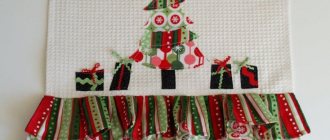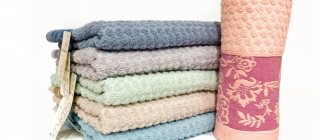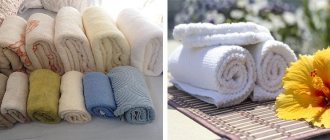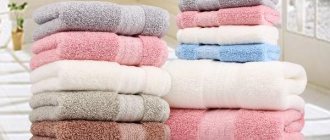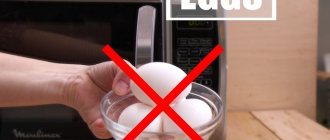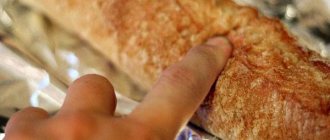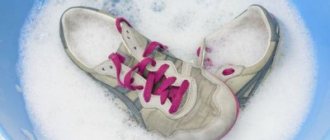Kitchen towels require frequent washing to remove tough stains. One way to tidy them up is to use a microwave.
Such a non-standard approach to solving the issue requires compliance with certain rules.
We'll tell you more about how to wash a kitchen towel in the microwave in this article.
When should you use this method?
If long-term boiling of textile products, soaking and washing them is not your thing, then it’s worth trying a new method.
Judging by the numerous reviews from those who have already used the microwave, the effect will not disappoint you, and as a bonus, you will save a lot of time. Few people associate a microwave oven with washing clothes; we usually heat food in it. But in some cases, only this will help solve the problem.
A washing machine is indispensable if the dirt is not too noticeable. But when washing, the machine will consume electricity, a lot of water, and at least an hour of time. Detergents will have to be selected to match different colors. And the main drawback is that heavy contamination will still not be removed.
Washing in the microwave does not have these disadvantages. Although, there is still one. It will not be possible to place many towels in the oven at the same time.
Washing machine or microwave: which is better?
An automatic washing machine has become a part of everyday life for any housewife; today, not everyone is able to give up this habitual method of washing. If you compare a microwave and a washing machine, the conclusion suggests itself about saving time, water and electricity when working with a microwave.
Washing in a washing machine takes several hours, so more electricity is consumed, and the same goes for water. And when using a microwave, much less time is spent. In the absence of a special powder for machine washing in the microwave, you can easily get by with ordinary laundry soap.
You need to get used to any innovation. Those housewives who chose to wash kitchen towels in the microwave no longer return to their usual methods. Ease, efficiency and cost-effectiveness allowed this method to firmly enter the life of a housewife. Free time is no less valuable; it can be spent communicating with children and family, and cleanliness in the kitchen will make you want to get together with your family more often for tea.
How it works"?
The ability of microwave radiation to quickly heat the contents in the oven is also used to achieve high temperatures during washing. The tissue structure is not damaged. Cleaning of fabric fibers occurs from the inside, when exposed to microwaves .
As a result, we do not get towels that look clean, but things that are actually clean on the outside and inside. Here's how it happens:
- a towel with a soap solution is placed in the microwave;
- microwaves heat the liquid inside the fabric fibers to a boil;
- under the influence of high temperature, the effectiveness of the detergent is greatly enhanced , as a result, even the most stubborn stains on the fabric disappear.
Is it possible to wash kitchen towels using a microwave?
At first glance, it seems that the microwave is the most inappropriate place for washing. After all, it is intended for completely different purposes - for heating food and drinks, quickly defrosting semi-finished products.
However, in reality the device can be used much more widely. Using a microwave oven, it is quite possible to wash heavily soiled kitchen towels in a few minutes and eliminate the unpleasant odor emanating from them. The bottom line is that under the influence of microwaves, wet textiles inside the unit reach a very high temperature, and under its influence the structure of even very persistent and old stains disintegrates.
The method is somewhat reminiscent of classic boiling. Only using a microwave is much more convenient, it gives a better quality effect, and washing takes less time.
Washing textiles in a microwave follows the following principles:
- First, the towel is thoroughly soaked in a soap solution - it is necessary that it completely saturates the fabric;
- then placed in the microwave in a sealed package made of heat-resistant material;
- then the microwave oven is turned on briefly, causing the soapy water in the fibers of the fabric to literally boil.
The method makes it possible to highly effectively remove stains from grease and difficult to remove food products. The microwave also eliminates the unpleasant odor that often comes from old towels even after washing.
Execution sequence
You can use this washing technology only by strictly following the procedure:
- wet a towel in cold water, rub it with laundry soap;
- put the wet item in a plastic bag without tying it (otherwise it will explode);
- place the package in the microwave;
- turn on for one and a half minutes, selecting medium power;
- carefully check whether the fabric is heated; if it is not hot enough, heating can be repeated;
- remove the towels with tongs;
- Rinse the towel with clean water and make sure there is no odor or dirt.
What not to do
When working with a microwave oven, you should remember simple safety rules with this electrical appliance:
- Do not use foil, as it produces a spark when heated;
- It is forbidden to use cling film, it will melt;
- do not touch the towels with your hands to avoid getting burned;
- do not tie a plastic bag when placing it inside the microwave - it may burst;
- Do not use paper bags, they may catch fire.
By following these rules, washing and bleaching in the microwave will give good results.
How to remove stubborn stains using this method?
the dirtiest towels before washing them in the microwave . To deal with difficult stains, use the following along with detergents:
- for traces of beets and tomatoes - citric acid;
- for moldy stains - acetic acid;
- from dried coffee - salt;
- greasy stains - dishwashing detergent.
The procedure for removing heavy stains is the same as for simple washing in the microwave described above. Instead of soap, it is better to treat the fabric with Antipyatin , add powdered bleach, or use dishwashing liquid. After this, also fold the laundry into a bag (no more than 3 towels), place in the oven for one and a half minutes at a power of about 450 .
Use tongs when removing from the microwave to avoid burns.
Tips for washing towels
Towels should be washed when they get dirty and as often as possible, without waiting until they become completely unusable. This rule applies to both colored towels and white ones.
If coffee, wine, juice or anything else that leaves stubborn stains has been spilled on fabric, you should start washing it as soon as possible.
Articles on the topic (click to view)
- How to become a great lawyer?
- All the pros and cons of forged beds in the interior
- 29 years - Velvet wedding: description, meaning, options for celebration and gifts
- Why are solid doors better?
- Features of pool paths
- Green kitchen interior
- Fences for parking lots and parking areas
It is very convenient to have several towels in the kitchen for different purposes: for wiping dishes, tables, hot pots.
Terry towels are the most difficult to clean, so waffle or linen towels are best suited for kitchen use.
Baking soda will help get rid of stains on white fabric. It effectively removes yellow stains and also gets rid of unpleasant odors. Soda should be added for pre-soaking, both instead of washing powder and along with it, then continue washing in any convenient way. It is safe to pour soda into the drum of an automatic machine.
Another recommended method for removing stains is a combination of soda and grated household soap diluted with water.
Mustard powder will also be an effective remedy for removing difficult grease stains. Dry mustard should be diluted with warm water, and then put towels there and leave for no more than 3 hours.
You can wash it using an interesting combination: 1 table. spoon of dry mustard, vinegar, sunflower oil. These ingredients together effectively remove greasy stains - no worse than a chemical cleaner.
[content-egg module=GdeSlon template=custom/grid3]
Whitening towels in the microwave
If textiles have lost their whiteness during use, you can bleach them in the same way. To do this, you will need a special microwave-safe dish that is deep enough to accommodate the bleaching items . Proceed as follows:
- Pour hot water into a microwave-safe container in such an amount that there is a little space left to the edge;
- dilute bleaching powder in the collected liquid at the rate of 100 grams per 1 liter;
- place towels there, preferably so that the water does not completely cover the items;
- cover with a plastic microwave lid (to prevent splashing);
- set to 700 watts;
- set the time to 10 to 15 minutes.
After bleaching, remove items, rinse in cold water and dry. Rinsing and spinning can be done in a washing machine. Thanks to microwaves, towels, shirts, and knitwear bleached in this way do not lose their shape and become perfectly clean.
Process Features
The microwave is an extraordinary method of washing; it is based on boiling water under the influence of microwaves emitted by the device. The result is almost the same as digestion.
The use of detergent compounds in the process makes washing even more effective, which is very important for kitchen towels. Heated soapy water begins to actively work, literally “pushing” dirt out of the fibers.
Advantages of using a microwave oven:
saving time (compared to boiling or washing in a washing machine);- the absence of a large amount of steam, the formation of which occurs during digestion;
- simplicity of the method;
- harmlessness to humans;
- ease of choosing a detergent - even ordinary soap will do;
- high efficiency.
Despite the heating, the structure of the material is not damaged when processed in the microwave. The purification process under the influence of radiation is directed from within.
Safety precautions
The above methods require compliance with safety precautions. By following them, you will prevent the possibility of damage to household appliances and avoid injury:
- Do not violate the instructions for using the microwave. Every electrical appliance is potentially dangerous if it malfunctions. The laundry bag may ignite if you turn the heat up too high or heat towels for more than 90 seconds. If one procedure does not bring results, repeat several times , but do not change the time and power indicators to avoid ignition.
- After washing, the appliance retains the smell of detergents, so it is advisable to use an oven in which you do not heat food. Do not leave the appliance unattended while washing.
- Important! You cannot replace a plastic bag with foil or film for food packaging ! The foil reflects radiation and sparkles. And the film may melt. Paper bags are also not suitable - there is a risk of fire.
- Do not remove the bag with your hands - this can cause burns.
Washing in the microwave, according to many housewives, is much more effective than washing in a washing machine. This method can improve the appearance of not only towels, but also other things - T-shirts, shirts, T-shirts.
Storing towels in the bathroom
How to get rid of the smell of towels
What to consider when washing
Washing nuances and advantages of waffle towels:
- they are universal in use, wash well and dry quickly;
- Do not use water with a temperature of more than 40 degrees;
- can be ironed with a hot iron;
- The drying method and the degree of spin do not matter.
What you need to know about linen towels:
- absorb moisture very well, while dirt on the surface is poorly retained;
- colored fabric can easily withstand many washes and does not fade;
- wear-resistant, wash and dry quickly;
- It is best to iron with a hot iron while the fabric is damp.
Cotton towels:
- are durable and not damaged by frequent washing;
- can be washed at high temperatures (withstands 90 degrees);
- It is better to separate colored fabrics from white ones to avoid staining;
- They take a long time to dry after washing, the fabric shrinks, so you should dry them hanging freely, not in a washing machine.
Washing methods
The microwave is a great way to remove old stains and rid fabrics of foreign odors. Since heating is carried out from the inside, deep cleansing occurs, rather than superficially washing away the freshest foreign particles. It is on this principle that all such washing methods are based.
On a note!
Most aggressive washing powders destroy the structure of natural fabrics from which kitchen towels are made. With regular washing, textiles will become unusable within a few months.
Using soap
To wash towels, just soak them in warm water and wait until they are completely wet; this will take no more than one minute. Squeeze out excess moisture thoroughly. Rub the fabric with laundry or bath soap without bright dyes. Place the prepared textiles carefully in a plastic bag. There is no need to close it; space is required for steam to escape. Set the microwave to medium power and the timer for 2 minutes.
You should remove it carefully, preferably with tongs, since the bag gets very hot. Rinse the treated textiles in warm water, wring out thoroughly and dry
This method allows you to:
- remove old stains;
- get rid of odors, including burning and vinegar;
- remove unpleasant yellowness;
- avoid washing out bright colors from the fabric.
Boiling and bleaching
White towels especially quickly lose their fresh appearance, which is not easy to get back. For such kitchen textiles, the microwave boiling method is suitable. It is necessary to take deep dishes designed specifically for heating by microwaves. You can fill it with warm or even cold water, but to save time and electricity it is better to use ready-made boiling water, if you have it. There is no need to fill to the brim; the liquid should be boiling, but not spilling onto the stand in the device. Bleaching agent should be added at the rate of 100 grams per 1 liter of liquid. Soak, but do not press down with a weight; they should float on the surface. Cover the container with a special plastic lid. Set the power to maximum, wash time – from 10 to 15 minutes, depending on the thickness of the fabric and the degree of its contamination.
For long pile
Products with long pile are not easy to wash, and after boiling they lose their softness. You can preserve the original properties of the product by using a non-standard washing method. The technology is the same as in the method with laundry soap. But after soaking, you need to rub the fabric with hair shampoo, and then warm it up in the same way in the microwave. After rinsing, the fabric will be soft, tender and fluffy. It is not necessary to use expensive shampoos; it is enough to choose a composition for dry and brittle hair.
Attention!
Even after such boiling, you should rinse the towels thoroughly, replacing the water several times. Do not get bleach on your skin, plates or kitchen utensils.
How to quickly remove odor and stains using folk recipes?
Various products can be used to remove stains and odors from items. Among them have proven themselves:
- vinegar,
- lemon acid,
- hydrogen peroxide,
- mustard,
- boiling,
- vegetable oil,
- using a microwave oven.
Vegetable oil
There are several options for using vegetable oil to clean kitchen towels from dirt.
In some cases, a combination of boiling water, oil and bleach is used, in others, a combination of boiling water and oil with washing powder, soda and vinegar.
It is recommended to wash only dry towels in a solution containing vegetable oil. For washing, you should use purified oil without any odor.
Read more about methods of washing textiles with vegetable oil here.
Microwave
With this express option, a textile product soaped with laundry soap is placed in a plastic bag and then placed in the microwave for 1-1.5 minutes. The microwave should operate at low power.
It is important not to overcook the towel in the oven, as there is a high risk of it catching fire.
Read more about this method here.
Boiling
With this method you need:
Soak dirty items for 1-2 hours in a solution containing a liter of hot water, a large spoon of salt and hand-washing detergent. Prepare a solution for boiling. Grate half a bar of 72 percent laundry soap. Place the shavings in a large saucepan with 5 liters of hot water, add 3 large tablespoons of soda and powder. To whiten white towels, you can add a large spoonful of stain remover to the solution.
Place dirty items into the solution and place the pan with them over medium heat. Boil the solution with textiles. After boiling, boil the kitchen towels for 20 minutes over low heat. Heavily soiled white cotton items can be boiled for up to 2 hours
It is important to stir the contents of the pan periodically. Remove the items from the pan and let them cool. Rinse thoroughly and then wring out items.
Do not boil colored or black towels. You should also avoid boiling white kitchen towels frequently. Hot water quickly destroys their fibers.
Vinegar
This product is recommended to be used as follows:
- pour a liter of warm water into a basin;
- add 1 glass of vinegar to it, use a solution of 5% or 9%;
- place dirty products in the resulting solution;
- soak them for 10 minutes;
- rinse things and hang them out to dry.
You can add half a cup of vinegar solution to the conditioner compartment of the washing machine. Vinegar will eliminate the unpleasant odor during washing.
Lemon acid
This product is recommended to be used as follows:
- Pre-wash the dirty towel with powder or laundry soap. Squeeze it out a little.
- Sprinkle citric acid on the area where the stain is. Wait 15 minutes. If the contamination is old, then you need to wait an hour.
- Rinse the product under water.
It is recommended to remove stains from tomatoes and beets using this method.
Hydrogen peroxide
This product is recommended for use in cases where there are old yellow stains on the item. It is enough to soak the textile product in the solution for half an hour. Then you need to wash the towel in the machine.
Hydrogen peroxide only helps in removing stains when it is fresh. Peroxide that has been left in an open bottle for a month will no longer have the desired effect in cleaning things from dirt.
Mustard
This method uses mustard powder. To do this you need:
- Dissolve 6 large spoons of mustard powder in 2 liters of warm water;
- let the mixture sit for half an hour;
- soak kitchen towels in the solution for 3-4 hours;
- Wash items soaked in the mixture in a machine.
You can mix a little mustard powder with water to form a paste and apply it to the stain.
Next, the product must be placed in a bag for 5 hours. After this, it must be rinsed and then washed.
Mustard powder is suitable for those cases when towels cannot be bleached or boiled.
Disinfecting kitchen sponges
If you need to rid your kitchen sponges of harmful bacteria, you can also use the microwave. To do this, dissolve a little table vinegar or lemon juice in water.
See also: Why do I now throw washing powder directly into the drum of the washing machine?
Then soak a sponge with it, which is then placed in the oven and left to heat for 1 minute.
During this time, 99% of dangerous microorganisms die. In rare cases, the sponge may begin to melt. So it's better to put it on a paper towel.
